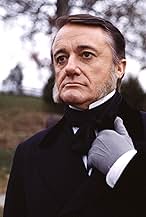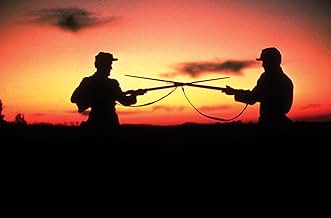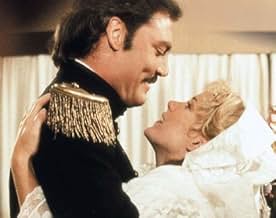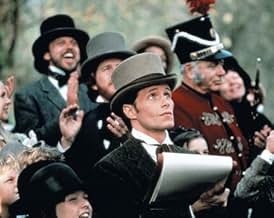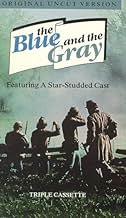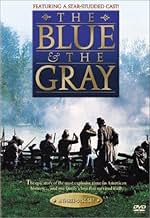AVALIAÇÃO DA IMDb
7,5/10
2 mil
SUA AVALIAÇÃO
Adicionar um enredo no seu idiomaAmerica just before and during the Civil War, as seen through the eyes of an artist correspondent.America just before and during the Civil War, as seen through the eyes of an artist correspondent.America just before and during the Civil War, as seen through the eyes of an artist correspondent.
- Indicado para 4 Primetime Emmys
- 2 vitórias e 4 indicações no total
Explorar episódios
Avaliações em destaque
I did not see this movie when it was shown as a mini-series.I happened to like this movie because it gave a simple portrayal of what it might have been like to be a family during this period and having to face the problem of a family that was divided in its loyalties . I thought the makers of this movie followed the history of the period and gave a good presentation of the issues that the people had to deal with at the time. Of course it cannot compare to the recent Civil War Movies or even the Ken Burns series . Given the time that it was made I think it was a good portrayal of the period.
My only fault with the movie was the fact that it seemed to put the fall of Vicksburg after the Gettysburg Address. I did not understand how this was allowed to happen given the fact that it seemed to be based on Bruce Catton's work. Can anyone explain this?
My only fault with the movie was the fact that it seemed to put the fall of Vicksburg after the Gettysburg Address. I did not understand how this was allowed to happen given the fact that it seemed to be based on Bruce Catton's work. Can anyone explain this?
Back in the early Sixties there was a short lived television series called The Americans about two brothers who after their father was killed decided to fight on opposite sides in the Civil War. The whole business about brother against brother was no exaggeration. Right up to the very top with Mary Todd Lincoln having relatives who fought for the Confederacy, families were torn apart. The Blue And The Gray brings that aspect of the Civil War better than any other film made for the big or small screen since The Americans.
The families are the Geysers and the Hales related by the mothers, Diane Baker and Colleen Dewhurst being sisters. The Hales are from Gettysburg, Pennsylvania and the Geysers from what would now be West Virginia in and around Harper's Ferry and that's not even 100 miles distance. But the families are true to the sectional divide.
With the exception of John Geyser played by John Hammond who has made a black friend, a free man played by Paul Winfield who gets lynched for helping runaway slaves. He won't fight for a section that espouses slavery as a cause, but won't enlist in the Northern Armies either. A passing acquaintance played by Stacy Keach who gets himself involved in a lot of the major events of the war and married into the Hale family with Julia Duffy persuades Hammond to become a war correspondent and put his artistic talents to good use. Hammond becomes a pictorial chronicler of the seminal event of his generation.
Without ever losing control of the main story lines, what happens to the various Geyser and Hale family members, The Blue And The Gray captures the sweep and pageantry of the Civil War. Such real characters as Abraham Lincoln played by Gregory Peck and John Brown played by Sterling Hayden in what was his farewell performance do take a life of their own. With Peck we see a public and a private Lincoln which is true to the Lincoln mythology and yet quite a human character.
If I had to single out one performance that was especially touching it would be that of David W. Harper as one of the Hale brothers. The young man was eager to be the first to enlist in his town of Gettysburg, but he never made it to the battle that town became famous for. A not well covered portion of the war was the lack of sanitary facilities in army camps. Young Harper falls victim to dysentery and his performance will move you.
A few years later North and South covered a lot of the same ground that this particular mini-series did and it was as well done as The Blue And The Gray. I would recommend them both highly especially for young audiences to gain a real understanding of what the Civil War meant to the average individual/
The families are the Geysers and the Hales related by the mothers, Diane Baker and Colleen Dewhurst being sisters. The Hales are from Gettysburg, Pennsylvania and the Geysers from what would now be West Virginia in and around Harper's Ferry and that's not even 100 miles distance. But the families are true to the sectional divide.
With the exception of John Geyser played by John Hammond who has made a black friend, a free man played by Paul Winfield who gets lynched for helping runaway slaves. He won't fight for a section that espouses slavery as a cause, but won't enlist in the Northern Armies either. A passing acquaintance played by Stacy Keach who gets himself involved in a lot of the major events of the war and married into the Hale family with Julia Duffy persuades Hammond to become a war correspondent and put his artistic talents to good use. Hammond becomes a pictorial chronicler of the seminal event of his generation.
Without ever losing control of the main story lines, what happens to the various Geyser and Hale family members, The Blue And The Gray captures the sweep and pageantry of the Civil War. Such real characters as Abraham Lincoln played by Gregory Peck and John Brown played by Sterling Hayden in what was his farewell performance do take a life of their own. With Peck we see a public and a private Lincoln which is true to the Lincoln mythology and yet quite a human character.
If I had to single out one performance that was especially touching it would be that of David W. Harper as one of the Hale brothers. The young man was eager to be the first to enlist in his town of Gettysburg, but he never made it to the battle that town became famous for. A not well covered portion of the war was the lack of sanitary facilities in army camps. Young Harper falls victim to dysentery and his performance will move you.
A few years later North and South covered a lot of the same ground that this particular mini-series did and it was as well done as The Blue And The Gray. I would recommend them both highly especially for young audiences to gain a real understanding of what the Civil War meant to the average individual/
This was a very good film about the Civil War. It showed the mindset of people living in the south during that era; how they were swayed into entering a futile and dangerous undertaking. The agony of war was shown at its worst, depicting the loss of the combatants as well as bystanders. Any war is horrible, but the war between the states is more so because of its utter uselessness. The waste of life and material should never have been allowed to happen. I recommend this movie; the action sequences are dramatic and well done, however, I felt some of the scenes seemed a bit underpopulated.
I first saw this mini-series while in 5th grade history class as part of our studies on the Civil War, and I thought it was excellent. Many years later, I watched it again after finding a copy of the unabridged version (all 6+ hours of it!). I wasn't sure how it would stand the test of time (both as a 16 year old production and my own view of it, being 16 years older now) and braced myself for disappointment; however, I was very pleasantly surprised. The movie is as well done as I remembered it.
It's an engrossing movie that gives an honest, frank look at the inherent moral ambiguity of war, as well as the additional consequences of the Civil War, where "brother fought brother". Although the movie certainly takes dramatic license (the main character, a young Southerner who relocates to the north after becoming disillusioned with the cruel treatment of slaves, ends up stumbling across his staunchly pro-Confederate siblings as if they're all wandering around in the same town instead of an entire country!), you can see that the film makers took great pains to portray as many perspectives as possible, to show that each and every person involved in the war was human, with their own thoughts and feelings. I'm certainly no Civil War expert, but I thought it was a very balanced portrait. What's more amazing is that the mini rarely drags despite sometimes taking a leisurely pace during its 6 hour run-time. Although we all know how the movie with ultimately end, it keeps you interested in the lives of all the characters it introduces. I thought Stacy Keach did a particularly good job despite a few hammy lines. This mini-series should definitely be on any must-see list of war films.
It's an engrossing movie that gives an honest, frank look at the inherent moral ambiguity of war, as well as the additional consequences of the Civil War, where "brother fought brother". Although the movie certainly takes dramatic license (the main character, a young Southerner who relocates to the north after becoming disillusioned with the cruel treatment of slaves, ends up stumbling across his staunchly pro-Confederate siblings as if they're all wandering around in the same town instead of an entire country!), you can see that the film makers took great pains to portray as many perspectives as possible, to show that each and every person involved in the war was human, with their own thoughts and feelings. I'm certainly no Civil War expert, but I thought it was a very balanced portrait. What's more amazing is that the mini rarely drags despite sometimes taking a leisurely pace during its 6 hour run-time. Although we all know how the movie with ultimately end, it keeps you interested in the lives of all the characters it introduces. I thought Stacy Keach did a particularly good job despite a few hammy lines. This mini-series should definitely be on any must-see list of war films.
Released in 1982 and directed by Andrew V. McLaglen, "The Blue and the Gray" covers the Civil War era from 1859-1865 focusing on two related families: The Geysers, farmers from Charlottesville, Virginia, and the Hales from Gettysburg, Pennsylvania, who own a newspaper. John Geyser (John Hammond) leaves Virginia to get a job as a sketch artist at the Hale's newspaper in Gettysburg. When war breaks out after the Southern states secede from the Union, John covers the war for Harper's Weekly.
MAIN CAST includes Stacy Keach as a Pinkerton-turned-Union-officer who romances John's cousin (Julia Duffy); Gregory Peck as Lincoln; Kathleen Beller as an aristocrat-turned-nurse; Dan Shor & Michael Horton as John's brother; Rip Torn as General Grant; and Lloyd Bridges & Colleen Dewhurst as Mr. and Mrs. Geyser. These are just the principle characters; there are scores of others (Robert Vaughn, Geraldine Page, Warren Oates, Robert Symonds, etc.).
I prefer "The Blue and the Gray" to the similar "North and South" (Books I & II, 1985-86) because it's more streamlined and less soap opera-y. Director McLaglen had decades of experience by this this time with both TV shows and films, including a few notable Westerns, like "Bandolero!" (1968) and "Chisum" (1970); in fact, his "Shenandoah" (1965) was a Civil War 'Western.'
The first half is great, but the second half flounders a bit and includes some cheesy plot gimmicks, like the mad slasher Confederate officer and John mistaking his babe (the nurse) supposedly making out with the Union stud (Keach). The 'floundering' includes some abrupt shifts, like from the Battle of Vicksburg (July, 1863) to the Battle of the Wilderness (May, 1864), which can likely be explained by cuts from the original mini-series. If you watch the longer version you probably won't encounter this problem.
What I like best about this "miniseries" (i.e. long movie) is that, despite some elements of TV-production cheese (e.g. the two Union & Confederate deserters' almost goofy meeting in the woods), the film takes you back in time to the Civil War era and provides a quality picture of what it was like.
Some of the notable events covered include: The Battle of Bull Run, Army camp life, dysentery in the camps, cowards in battle and the branding thereof, balloon reconnaissance, fraternizing with the enemy after hours, brother vs. brother, the Gettysburg Address, the siege of Vicksburg and the desperation thereof (e.g. the Caves), prisoner-of-war camps (Elmira), Lee's surrender and Lincoln's death. Yes, some key events are off-screen (e.g. the Battle of Gettysburg and Lincoln getting shot), but that's the nature of the beast with a TV-budget and an overview-styled story. Lastly, Keach shines as one of the main protagonists, easily one of his best rolls, and Duffy is a delight.
The film runs 296 minutes (4 minutes shy of 5 hours), with the original 3-part miniseries running 381 minutes. It was shot entirely in Arkansas (Fort Smith, Eureka Springs, Fayetteville, Van Buren & Prairie Grove Battlefield State Park). The script was written by John Leekley & Ian McLellan Hunter based on Bruce Catton's material.
GRADE: B
MAIN CAST includes Stacy Keach as a Pinkerton-turned-Union-officer who romances John's cousin (Julia Duffy); Gregory Peck as Lincoln; Kathleen Beller as an aristocrat-turned-nurse; Dan Shor & Michael Horton as John's brother; Rip Torn as General Grant; and Lloyd Bridges & Colleen Dewhurst as Mr. and Mrs. Geyser. These are just the principle characters; there are scores of others (Robert Vaughn, Geraldine Page, Warren Oates, Robert Symonds, etc.).
I prefer "The Blue and the Gray" to the similar "North and South" (Books I & II, 1985-86) because it's more streamlined and less soap opera-y. Director McLaglen had decades of experience by this this time with both TV shows and films, including a few notable Westerns, like "Bandolero!" (1968) and "Chisum" (1970); in fact, his "Shenandoah" (1965) was a Civil War 'Western.'
The first half is great, but the second half flounders a bit and includes some cheesy plot gimmicks, like the mad slasher Confederate officer and John mistaking his babe (the nurse) supposedly making out with the Union stud (Keach). The 'floundering' includes some abrupt shifts, like from the Battle of Vicksburg (July, 1863) to the Battle of the Wilderness (May, 1864), which can likely be explained by cuts from the original mini-series. If you watch the longer version you probably won't encounter this problem.
What I like best about this "miniseries" (i.e. long movie) is that, despite some elements of TV-production cheese (e.g. the two Union & Confederate deserters' almost goofy meeting in the woods), the film takes you back in time to the Civil War era and provides a quality picture of what it was like.
Some of the notable events covered include: The Battle of Bull Run, Army camp life, dysentery in the camps, cowards in battle and the branding thereof, balloon reconnaissance, fraternizing with the enemy after hours, brother vs. brother, the Gettysburg Address, the siege of Vicksburg and the desperation thereof (e.g. the Caves), prisoner-of-war camps (Elmira), Lee's surrender and Lincoln's death. Yes, some key events are off-screen (e.g. the Battle of Gettysburg and Lincoln getting shot), but that's the nature of the beast with a TV-budget and an overview-styled story. Lastly, Keach shines as one of the main protagonists, easily one of his best rolls, and Duffy is a delight.
The film runs 296 minutes (4 minutes shy of 5 hours), with the original 3-part miniseries running 381 minutes. It was shot entirely in Arkansas (Fort Smith, Eureka Springs, Fayetteville, Van Buren & Prairie Grove Battlefield State Park). The script was written by John Leekley & Ian McLellan Hunter based on Bruce Catton's material.
GRADE: B
Você sabia?
- CuriosidadesSome filming took place at Prairie Grove Battlefield State Park in Arkansas. The film crew built a false side onto a historic building there, then blew it off for a special effect, assuring the State park officials that no harm would come to the building. The explosion was larger than promised, damaging the historic house's structure.
- Erros de gravaçãoWhen John Brown is hanged for the uprising at Harper's Ferry, the apple trees are in full blossom. John Brown was hanged on 2 December 1859.
- Citações
Abraham Lincoln: It's well known that the more a man speaks, the less he's understood.
- ConexõesReferenced in Saturday Night Live: Drew Barrymore/Squeeze (1982)
- Trilhas sonorasRock of Ages
Lyrics by Augustus Montague Toplady (as Augustus M. Toplady)
Music by Thomas Hastings
Principais escolhas
Faça login para avaliar e ver a lista de recomendações personalizadas
- How many seasons does The Blue and the Gray have?Fornecido pela Alexa
Detalhes
- Data de lançamento
- País de origem
- Idioma
- Também conhecido como
- Die Blauen und die Grauen
- Locações de filme
- Empresas de produção
- Consulte mais créditos da empresa na IMDbPro
Contribua para esta página
Sugerir uma alteração ou adicionar conteúdo ausente

Principal brecha
By what name was The Blue and the Gray (1982) officially released in India in English?
Responda

